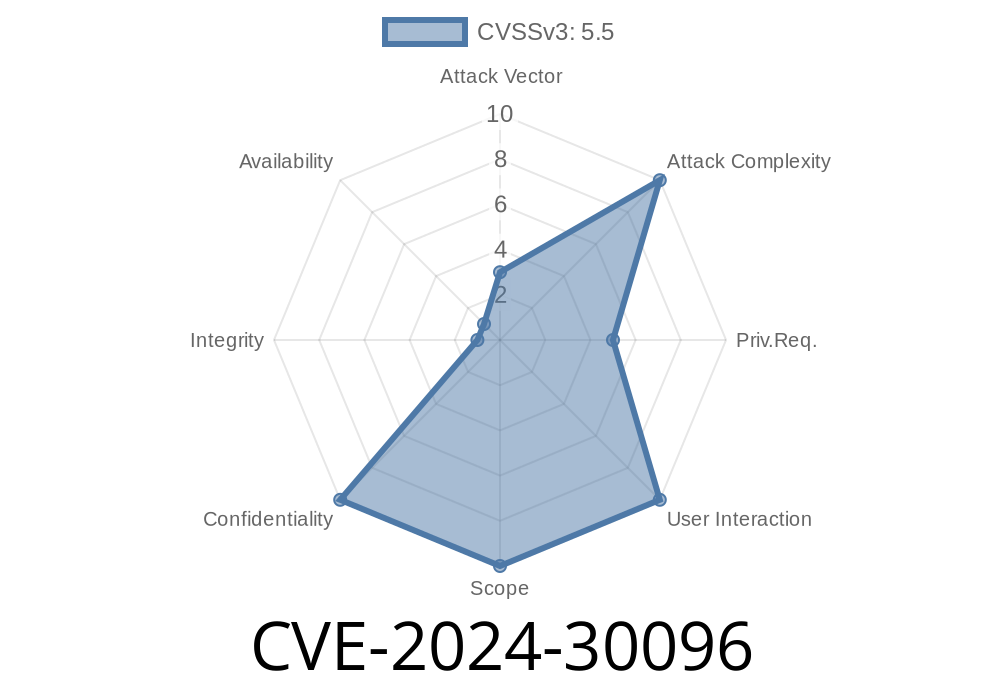Microsoft recently disclosed a new vulnerability—CVE-2024-30096—in their June 2024 Patch Tuesday updates. This particular bug affects Windows Cryptographic Services, introducing the risk of information disclosure on multiple supported versions of Windows. This post explores what CVE-2024-30096 is, how it might be exploited, and best practices for mitigation, using clear explanations and examples.
What is CVE-2024-30096?
CVE-2024-30096 is an information disclosure vulnerability in the Windows Cryptographic Services, a core component of Windows responsible for enabling secure encryption and decryption on your computer. According to Microsoft's advisory, the flaw could let an attacker who already has local access to your system read parts of memory that should otherwise be inaccessible. This means sensitive information such as private keys, passwords, or other confidential data could be exposed if the vulnerability is exploited.
Official References
- Microsoft Security Guide: CVE-2024-30096
- Patch Tuesday June 2024 Overview (BleepingComputer)
How Does the Vulnerability Work?
The issue originates in how Cryptographic Services handles certain requests in memory. If a process is mishandled, parts of system memory that should remain hidden can be read by lower-privileged users.
While Microsoft and other vendors have not published a public proof-of-concept (PoC), the general class of vulnerability is information leakage via unsafe memory handling.
A Simplified Exploit Scenario
Suppose a malicious user has some form of local access—either user-level or through a low-privileged application. They could use specially crafted code to request cryptographic operations in a way that retrieves more information than intended.
Here's a general (and simplified) demonstration in pseudo-code
# Python pseudocode:
# Exploiting a memory disclosure via Windows CryptoAPI
import os
import ctypes
# Supposedly, a normal function call
def trigger_crypto_leak():
# This function would call into the affected CryptoAPI
# Normally, data returned would be limited
data = os.system("certutil -decode bogus_input bogus_output")
# If vulnerable, 'bogus_output' may contain leaked information from process memory
with open("bogus_output", "rb") as leaked:
print(leaked.read())
trigger_crypto_leak()
Note: The above code is illustrative only; real-world exploitation would require detailed knowledge of the memory structures and specific techniques to trigger the bug, likely in C or C++ with direct Windows API calls. No working public exploit currently exists.
Why is CVE-2024-30096 Important?
- Information disclosure is often an important initial step for attackers. Once sensitive data is leaked, it could help with further exploitation (like privilege escalation or lateral movement).
- High-value targets: Servers and enterprise workloads frequently depend on cryptographic services. Exposed keys or credentials can have serious, far-reaching consequences.
Mitigation Steps
Microsoft has provided patches as part of the June 2024 updates. The best course of action is to update your Windows systems immediately, prioritizing servers and endpoints handling sensitive cryptographic operations.
Additional References and Reading
- CVE-2024-30096 at NVD
- Microsoft Guidance on Windows Cryptographic Services
- Patch Tuesday Analysis by Tenable
Conclusion
CVE-2024-30096 is a serious memory disclosure flaw in Windows Cryptographic Services. Although no public exploit currently exists, security best practices dictate that such flaws should be patched immediately. Stay vigilant for any new developments, and always keep your systems updated.
Do you have questions about this vulnerability or need help applying patches? Let us know in the comments below!
Timeline
Published on: 06/11/2024 17:15:58 UTC
Last modified on: 07/19/2024 21:13:36 UTC
